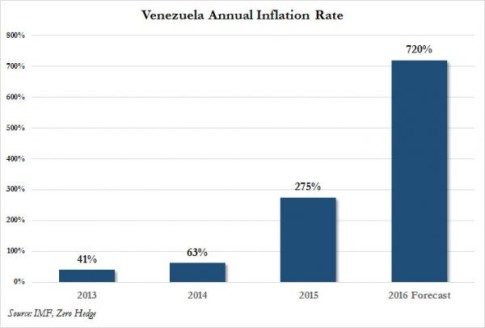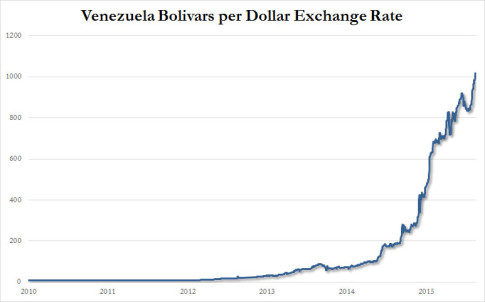– Hyperinflating Venezuela Used 36 Boeing 747 Cargo Planes To Deliver Its Worthless Bank Notes:
The weeks ago, when we showed “What The Death Of A Nation Looks Like: Venezuela Prepares For 720% Hyperinflation“, we said that after looking at a chart of Venezuela’s upcoming hyperinflation…
… a hyperinflation in which the soaring stock market has failed to keep pace with the collapsing currency, thereby mocking all erroneous thought experiments that under hyperinflation being long the stock market is a sure hedge to currency destruction…
… we joked that it is unclear just where the country will find all the paper banknotes it needs for all its new currency.
After all, central-bank data shows Venezuela more than doubled the supply of 100-, 50- and 2-bolivar notes in 2015 as it doubled monetary liquidity including bank deposits. Supply has grown even as Venezuela has fewer U.S. dollars to support new bolivars, a result of falling oil prices.
This question, as morbidly amusing as it may have been to us if not the local population, became particularly poginant yesterday, when for the first time, one US Dollar could purchase more than 1000 Venezuela Bolivars on the black market.
And, as if on cue, the WSJ answered. As it turns out we were not the only ones wondering how the devastated “socialist paradise” gets its exponentially collapsing paper currency, which in just the past month has lost 17% of its value.
The answer: 36 Boeing 747s.
From the WSJ:
Millions of pounds of provisions, stuffed into three-dozen 747 cargo planes, arrived here from countries around the world in recent months to service Venezuela’s crippled economy.
But instead of food and medicine, the planes carried another resource that often runs scarce here: bills of Venezuela’s currency, the bolivar.
The shipments were part of the import of at least five billion bank notes that President Nicolás Maduro’s administration authorized over the latter half of 2015 as the government boosts the supply of the country’s increasingly worthless currency, according to seven people familiar with the deals.
More planes are coming: in December, the central bank began secret negotiations to order 10 billion more bills, five of these people said, which would effectively double the amount of cash in circulation. That order alone is well above the eight billion notes the U.S. Federal Reserve and the European Central Bank each print annually—dollars and euros that unlike bolivars are used world-wide.
This means that Venezuela’s hyperinflation, already tentatively estimated at 720%, will likely add on a few (hundred) zeroes by this time next year. It is also quite likely that Venezuela the country, as we know it now, will no longer exist because once any country is swept up in hyperinflationary rapids two things occur like clockwork: social uprisings and political coups.
But before it gets there, Venezuela’s president Maduro will be busy liquidating the nation’s roughly $12 billion in gold reserves, which his late predecessor fought hard in 2011 to repatriate back to Caracas. Sadly that gold was never meant to stay in Venezuela after all.
Meanwhile, life in Venezuela is disturbingly comparably to that under Weimar Germany, wheelbarrows of cash and all:
While use of credit cards and bank transfers is up, Venezuelans have to carry stacks of cash as many vendors try to avoid transaction fees. Dinner at a nice restaurant can cost a brick-size stack of bills. A cheese-stuffed corn cake—called an arepa—sells for nearly 1,000 bolivars, requiring 10 bills of the highest-denomination 100-bolivar bill, each worth less than 10 U.S. cents.
Rigid state price controls have only made matters worse, economists say, generating a thriving black market for just about every good, from car tires to baby diapers, in which cash is the preferred form of payment.
Adding insult to injury the very process of printing the almost instantly worthless currency costs Venezuela hundreds of millions of dollars.
“The bank-note buying spree is costing the cash-strapped leftist government hundreds of millions of dollars, said all seven of the people, who have been briefed on the deals Venezuela has entered with bank-note producers.”
But it gets even more ridiculous for the government where the largest bill in denomination is 100 Bolivars:
The high cost of the printing binge is an especially heavy burden as Venezuela reels from the oil-price collapse and 17 years of free-spending socialist rule that have left state finances in shambles.
Most countries around the world have outsourced bank-note printing to private companies that can provide sophisticated anticounterfeiting technologies like watermarks and security strips. What drives Venezuela’s orders is the sheer volume and urgency of its currency needs.
The central bank’s own printing presses in the industrial city of Maracay don’t have enough security paper and metal to print more than a small portion of the country’s bills, the people familiar with the matter said. Their difficulties stem from the same dollar shortages that have plagued Venezuela’s centralized economy, as the Maduro administration struggles to pay for imports of everything, including cancer medication, toilet paper and insect repellent to battle the mosquito-borne Zika virus.
That means Venezuela has to buy bolivars from abroad at any cost. “It’s easy money for a lot of these companies,” one of the people with details on the negotiations said.
Venezuela’s misery means a hefty pay day for those who end up printing its worthless currency, among them, the same company which printed Weimar’s own currency:
The huge order for 10 billion notes can’t be satisfied by a single firm, the people familiar with the deals said. So it has generated interest from some of the world’s largest commercial printers, each vying for a piece of the pie at a time when low profits in bank-note printing have pushed many of them to cut back on capacity.
According to the people familiar with the deals, the companies include the U.K.’s De La Rue, the Canadian Bank Note Co., France’s Oberthur Fiduciaire and a subsidiary of Munich-based Giesecke & Devrient, which printed currency in 1920s Weimar Germany, when citizens hauled wheelbarrows of cash to buy bread. More recently, the German technology company was the source of security paper for Zimbabwe when it was stricken in 2008 with a hyperinflation episode in which prices doubled daily.
Wait a minute, why not just print a single 100,000,000 Bolivar note instead of one million 100 bolivar bills? After all the savings on the printing, let along the air freight, to the already insolvent country will be tremendous and allow it to pretend it is not a failed nation for at least a few more days? It is here that the sheer brilliance of the rulers of this socialist paradise shines through:
Currency experts say the logistical challenges of importing and storing massive quantities of bank notes underscore an undeniable truth: Venezuela is spending a lot more than it needs because the government hasn’t printed a higher-denomination bank note—revealing a misplaced fear, analysts say, that doing so would implicitly acknowledge high inflation the government publicly denies.
“Big bills do not cause inflation. Big bills are the result of inflation,” said Owen W. Linzmayer, a San Francisco-based bank-note expert and author who catalogs world currencies. “Larger bills can actually save money for the central bank because instead of having to replace 10 deteriorated notes, you only need five or one,” he said.
The Venezuelan central bank’s latest orders have been exclusively only for 100- and 50-bolivar notes, according to the seven people familiar with the deals, because 20s, 10s, 5s and 2s are worth less than the production cost.
Mr. Maduro and his allies say galloping consumer prices reflect a capitalist conspiracy to destabilize the government.
Well, no, but at this point one may as well sit back and be amused by the idiocy of it all. But at least we will give Maduro one thing: he has done away with the pretense that when push comes to shove, the state and the central bank (and thus commercial banks) are two different things: “the president in late December changed a law to give himself full control over the central bank, stripping congressional oversight just as his political opponents took control of the National Assembly for the first time in 17 years.”
Finally, while the rest of the world is wrapped up in such deflationary monetary madness as negative interest rates, Venezuela is subject to monetary lunacy too, only of a far more familiar, hyperinflationary kinds:
A color photocopy of a 100-bolivar bill costs more than the note. In an image that went viral on social media, a diner is shown using a 2-bolivar note to hold a greasy fried turnover because it is cheaper than a napkin.
And before we close this latest chapter on our ongoing chronicle of Venezuela’s complete economic disintegration, we are delighted to find that Kyle Bass’s “nickel” idea has made its way even in this Latin American socialist paradise:
On a recent day, a 46-year-old slum-dweller named Mario walked the streets of a wealthy district of Caracas with a megaphone, calling on residents to sell him their coins, which he gathered into a rolling water cooler. The idea: to melt it down later.
“You can make an amazing ring,” said Mario, who wouldn’t give his last name but said he preferred to go by his nickname, Moneda, or “Coins.”
Now if only Venezuela had a way of exporting some of its hyperinflation to the rest of the world, drowning in “deflation” the result of a few hundred trillion in debt. Actually, fear not: ultimately hyperinflation is easy to achieve – Venezuela is a good example of this; what is difficult is to admit when the current system has failed and when importing 36 Jumbo Jets full of cash is the only solution.
With every passing day, the rest of the “Developed Word” gets one step closer to recreating Venezuela’s experience.


